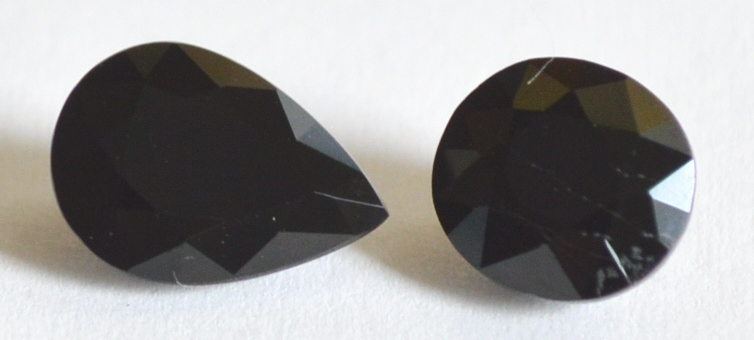
The Colours of Tourmaline, Part 4: Other Tourmaline Species
Share
By Yaĝé Enigmus
While the majority of coloured tourmaline gemstones encountered are composed of elbaite tourmaline, there are other tourmaline minerals which are occasionally seen in jewellery. The most important of these are schorl tourmaline, dravite tourmaline, uvite tourmaline, and liddicoatite tourmaline.
Schorl Tourmaline

The most common tourmaline mineral is schorl, which is colloquially known by the name “black tourmaline” due to its black colour and opaqueness. This sodium iron tourmaline was known in Europe prior to the introduction of coloured tourmalines and their subsequent classification as a mineral group, with this stone’s name deriving from the village of Schorl (now “Zschorlau”) in Saxony, Germany where the mineral was mined alongside cassiterite before the year 1400. During the Victorian era, schorl was an especially popular gemstone, but today it is not used in jewelry as frequently as it once was. Some black tourmalines are not truly schorl and other tourmaline minerals, such as dravite and uvite, may be dark enough to appear black and opaque without closer examination.
Dravite Tourmaline

Dravite tourmaline is an uncommon member of the tourmaline group, but it does appear on the jewellery market. This sodium magnesium tourmaline is named after the Drava River valley in what is now modern day Slovenia where the mineral was first described by Western scientists. Many brown tourmaline gemstones and some stones with earth-yellow or burnt orange colour are indeed dravite tourmaline; these hues are produced by trace amounts of the same iron to titanium charger transfer (Fe2+-Ti4+) that is responsible for some of the earth tones of elbaite tourmaline.

A brown dravite tourmaline crystal from the Yinnietharra Dravite Mine, Western Australia, Australia. Image: Weinrich Minerals/ Mindat
Chrome Tourmaline

The rarest and most valuable variety of dravite tourmaline exhibits a bright green colour due to trace impurities of chromium (Cr3+) and/or vanadium (V3+). This form of dravite is known as “chrome tourmaline” in reference to its chromium content, although rather interestingly the majority of gemstones described this way lack chromium (Cr3+) and are coloured exclusively by vanadium (V3+); despite this, the name “chrome tourmaline” is still used by members of the trade for all dravite gemstones of this variety. Some elbaite gemstones and uvite gemstones may be coloured green by chromium (Cr3+) and/or vanadium (V3+), but the majority of stones referred to as “chrome tourmaline” are composed of dravite tourmaline. Vanadium is not as readily detectable in tourmaline as chromium, so some chrome tourmalines of dull colour may be mistaken for verdelite tourmaline.
Uvite Tourmaline
Uvite tourmaline is a rare member of the tourmaline group that is rarely seen in jewellery, but may occasionally masquerade as other tourmaline gemstones. This magnesium calcium iron tourmaline was first described by Western scientists in the year 1929 in the Uva Province of Sri Lanka, after which it was named. Uvite may exhibit both green and brown hues that resemble green elbaite and/or green/brown dravite, frequently being mistaken for these tourmaline species. In some cases uvite may also be so dark and opaque that the stone appears to be schorl tourmaline.
Liddicoatite Tourmaline

Another rare tourmaline mineral that may be used as a gemstone is liddicoatite tourmaline. Liddicoatite is a calcium lithium aluminum tourmaline that is extremely difficult to distinguish from elbaite; in actuality, pure liddicoatite has not yet been found in nature, and naturally occurring stones would be more accurately described as fluor-liddicoatite which has a single fluorine (F) substituted for one of its hydroxyl groups (OH). First described by Western scientists in Madagascar, this tourmaline mineral was named after former president of the Gemological Institute of America and champion of the GIA diamond grading system, Richard T. Liddicoat, in 1977. Liddicoatite is most famous for its elbaite-like colour zoning, and some polychrome tourmaline gemstones are cut from crystals of liddicoatite. Some rubellite tourmaline gemstones are in fact liddicoatite coloured by trace impurities of the same trivalent manganese (Mn3+) which is responsible for the red and pink hues seen in elbaite. In very rare cases, indicolite tourmaline gems may be liddicoatite coloured by the same iron impurities ( Fe2+/Fe2+-Fe3+) that produce blue hues in elbaite, and recently it was discovered that a small percentage of cuprian tourmalines are actually copper (Cu2+) bearing liddicoatite.

A polychrome liddicoatite slice from the Anjanabonoia Pegmatite, Madagascar. Image: Robert Weldon/ Gemological Institute of America
Here are more elegant tourmaline gemstones currently available from Skyjems!
|
|
© Yaĝé Enigmus












